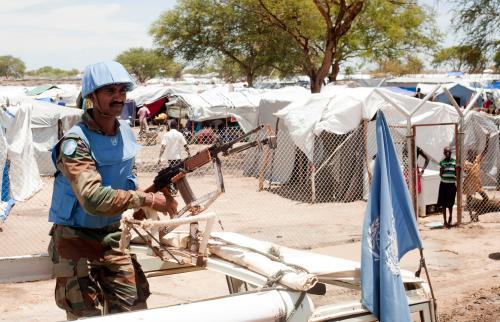The UN Secretary General visited Pakistan’s flood-hit areas and summed up the situation best when he said that it was an ‘enormous disaster.’ The Secretary General noted that he had ‘never seen anything like the devastation created by the floods’ with ‘so many people, in so many places in so much need.’ The scale of the human tragedy is near epic and likely hard for outsiders to fathom; flood waters have submerged one-fifth of Pakistan—roughly an area the size of Florida, leaving over 1600 dead and an estimated 20 million displaced. Towns, villages, crops, livestock, personal possessions and infrastructure have been completely washed away. Diseases now threaten the people in makeshift camps, signaling a catastrophic sequel to the floods.
It is early to weigh the long-term consequences, but they are worrisome. The statistics being quoted indicate the massive economic consequences of the floods. A major gas field and six power plants have been shut down, adding another 1500 megawatts to the already 4500 megawatts power shortfall. Besides the destruction of infrastructure like bridges, irrigation canals, homes, roads and railway tracks, there is large scale damage to agriculture; almost 17 million acres of farmland have been flooded and billions of dollars worth of crops and livestock destroyed. Three of Pakistan’s four provinces are affected by the floods, which is notable in a country where 22% of the economy is dependent on agriculture and two-thirds of the 180 million people are in agriculture related work. The impact on the economy will be enormous and early estimates are that growth will be halved. This indicates that instead of the projected 4.5% it will be less than 2.5%. The further consequence is that the IMF target of capping the budget deficit at 5.1 % of the GDP is unlikely to be met. In fact, the $55 billion external debt (servicing it takes away 23% of export earnings) is set to grow, adding to the already declining economic situation. Experts are predicting a massive drop in exports and an increase in food imports, further adding to the trade deficit. The overall effect is that in spite of the endurance and resilience shown by Pakistanis in past disasters, there is likely to be prolonged disruption; rehabilitation may take anything up to five years or more with a total requirement of over 10 billion US dollars.
The political side is also worth watching. There will inevitably be political and economic fallout from the evolving situation, though there is no likelihood of any drastic change in the political environment. The floods come in the wake of an ongoing insurgency in the western border areas that is linked to the situation in Afghanistan as well as extremist militant groups in the country’s heartland. The Pakistan military that had been conducting counter insurgency campaigns has had to employ over 60,000 troops and its aviation assets for disaster relief; so far, there are no signs that this has impacted on its operations in the border belt, but no nation has infinite resources. The military also cancelled the annual Independence Day and Defense of Pakistan Day events to divert funds towards flood relief. The political leadership, after some initial missteps, came together in a joint conference and has decided on an independent commission to coordinate and administer flood relief efforts. In the wake of the flood, the government’s capacity is being seriously challenged, as governance problems increase and fears of social unrest triggered by rising prices and energy shortfalls increase. The internal security situation remains fragile after the politically motivated ethnic killings in Karachi and the religious-sectarian violence in Punjab and the ongoing ethnic targeted murders in Baluchistan. This internal environment could be exploited to create more destabilization, adding to the problems.
In the face of these internal dynamics, the UN and Pakistani government have both indicated that international response has been slow. The World Bank and the Asian Development Bank will complete a joint ‘damage need assessment ‘by mid October. The World Bank has pledged $900 million and the U.S. is supporting with massive relief efforts—$55 million already committed in addition to the aid already being given and seven U.S. military helicopters flying rescue and relief missions with 12 more on the way. The UK is also making a significant contribution. There is growing appreciation of U.S. support in public opinion, just as there was in the 2005 earthquake disaster in Pakistan. U.S. media is voicing some fears of ‘Islamic militant charities’ making inroads through relief work and a weakening of Pakistan’s military operations in the west, but these are just fears. The Pakistani military clearly is the lead agency in relief management.
The overall result is that Pakistan needs massive support, as the magnitude of the requirement is clearly beyond its own capacity, both in terms of resources and expertise. Outside nations should view this not cynically, but though a lens of both aid and strategy. The human need is obvious; Pakistan’s stability is critically important to the end result sought by the U.S. in Afghanistan, while an improvement in South Asian stability, and most importantly the India-Pakistan relationship, would make a significant difference in the overall environment.



Commentary
Pakistan’s Water World: The Political and Economic Impact of the Recent Floods
August 17, 2010